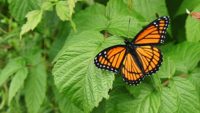How did their digestive biology change to make them need meat? …read more Source: creation.com
By Dr. Carrie John The viceroy is a colorful butterfly that is known to mimic other species. But it is not just a tasty option that looks like the unpalatable models it mimics. …read more Source: AIG Daily
By Harry F. Sanders, III The clownfish is clearly designed for the environment in which it lives while providing some startling challenges to the standard evolutionary model. …read more Source: AIG Daily
By Dr. David Menton The secret ingredient to continual breathing? Water. …read more Source: AIG Daily
By Harry F. Sanders, III Life cycles are an interesting thing to study. Organisms are born and produce offspring in so many ways. …read more Source: AIG Daily
We’re all familiar with antibiotic resistance building in the human population.1 Antibiotics are widely prescribed, but many are largely unnecessary. This contributes to the development of “superbugs.”2 Evolutionists list antibiotic resistance as evidence of evolution3, but in reality it has nothing to do with the origin of antibiotic resistance genes4 More… …read more Source: icr.org
God gifted creation with natural builders to restore habitats and create ecosystems. Since April 7 is International Beaver Day, let’s look at the busy builders. …read more Source: AIG Daily
Cell biologists have long focused on the tiniest of interactions: those between molecules. Recently, some researchers have zoomed out just a little to take a fresh look using new technologies at those cellular compartments, called organelles. Their discoveries give new insight into diseases, prompt a desire to redraw all the standard textbook cell pictures, and challenge anyone who still thinks of cells as simple blobs of protoplas… More… …read more Source: icr.org
Because of grievous deficiencies in the standard neo-Darwinian Model of evolution, which is largely selection driven, scientists proposed an alternative postulate called the ‘Neutral Model’ in the late 1960s. The Neutral Model is also mutation driven, but selection is deemed to be an insignificant force of change. Instead, random genetic drift is alleged to be the main driver. Since its inception, the Neutral Model has come to be incorporated in many theoretical evolutionary scenarios at some level. However, due to numerous discoveries in genomics and genome function, the Neutral Model has also become deficient, prompting a new move in science [More]
Tiny diatom frustules reveal God’s beautiful design. Read More
By Dr. Carrie John Recently published research discusses the synthesis of a large molecule which folded into a ring pattern and compared it to the folding of proteins. …read more Source: AIG Daily
It’s been known for decades that the hot pools of Yellowstone National Park contain exceptional and robust types of prokaryotic microorganisms called Archaea. Previously known as the archaebacteria, these organisms include methanogens (methane producers), extreme thermophiles (organisms resistant to heat), and extreme halophiles (organisms requiring salt for growth). One species of thermophilic archaea is Sulfolobus that can … More… …read more Source: icr.org
Termites (order Isoptera) are eusocial—animals with an advanced social organization—insects that can number in the millions, producing something biologists call a superorganism. This is defined as a colony of termites having features of organization analogous to the properties of a single creature. These insects have the ability to digest wood due to symbiotic gut-dwelling flagellates, single-celled eukaryotic creatures… More… …read more Source: icr.org
Neo-Darwinism, Neutral evolution, and the ‘Extended Evolutionary Synthesis’ cannot avoid the multilayered complexity of the genome and cell. …read more Source: creation.com
Robotics engineers trying to copy human bipedal locomotion have a long way to go …read more Source: creation.com
By Troy Lacey A recent study was published purporting to explain how snakes lost their limbs, and it revealed some surprising findings. …read more Source: AIG Daily
Why are man-made pills increasingly ineffective in the battle against infections? …read more Source: creation.com
Every person is an important ecosystem for a wide variety of microorganisms. Whether it’s the bacterial collection of coliforms in our large intestine, streptococci in our mouth, or the diptheroids on our skin, it’s the normal flora or normal microbiota. The microbial colonization of our gut, for example, supports the digestion of complex nutritional components and activates anatomical changes of the intestine. This total collec… More… …read more Source: icr.org
By Ken Ham In 1955, more than a dozen strange-looking killer whales were stranded on a beach in New Zealand. Called “type D” killer whales, they were virtually unknown in the wild to science, except in a few photographs and fisherman stories, from that time on. But, as National Geographic reports, scientists have now observed a pod of these whales for the first time. Scientists headed for the dangerous waters off the tip of South America where these whales reportedly patrol the seas. After waiting for a week, a pod of whales finally approached the anchored research vessel. Scientists were [More]
By Ken Ham Order your copy of Glass House: Shattering the Myth of Evolution today! You see, God created organisms to reproduce according to their kinds. Cats produce cats, dogs produce dogs, and elephants produce elephants. But God built tremendous genetic diversity into the DNA of every kind that he made. This allows them to spread out and fill the earth, adapting to different ecological niches. That’s why we can have wolves that thrive in the cold arctic, coyotes that scavenge at the local city dump, and dingoes that hunt on the grasslands and deserts of Australia. They’re all dogs, [More]
The incredible basilisk has an amazing ability that allows it to skim across the water. …read more Source: creation.com
Well-funded YouTube video falls far short in explaining how consciousness evolved …read more Source: creation.com
Recent headlines claim, “Scientists Have Witnessed a Single-Celled Algae Evolve Into a Multicellular Organism.”1 In reality, the experiment showed that nothing more than a crude clumping together of individual cells had occurred. A new multicellular organism was not created, nor was any real evolution observed. One of the major hurdles in the grand story of molecules to man evolution is how life… More… …read more Source: icr.org
A new study by NASA scientists has just been published where researchers did nothing more than convert a pre-cursor chemical into a single type of amino acid. Despite the simplicity of this experiment and the lack of anything helpful to evolution being found, the popular media exclaimed that the scientists were able to “recreate the ‘origins of life’ and the results are shocking.”1,2 In reality, the only t… More… …read more Source: icr.org
The amazing changes in a new born baby’s circulation …read more Source: creation.com
Evolutionists claim that an eight-letter DNA alphabet called hachimoji allows for more varied evolution of life, but simple science shows otherwise. Read More
One of the most complex biochemical processes in God’s creation is the ability plants possess to take in carbon dioxide and water and, with the aid of sunlight, turn it into energy-rich sugars. Most of us learned about this amazing process called photosynthesis in school. It’s designed to be the route by which virtually all energy enters Earth’s ecosystems. If you have studied photosynthesis, you can appreciate ju… More… …read more Source: icr.org








































